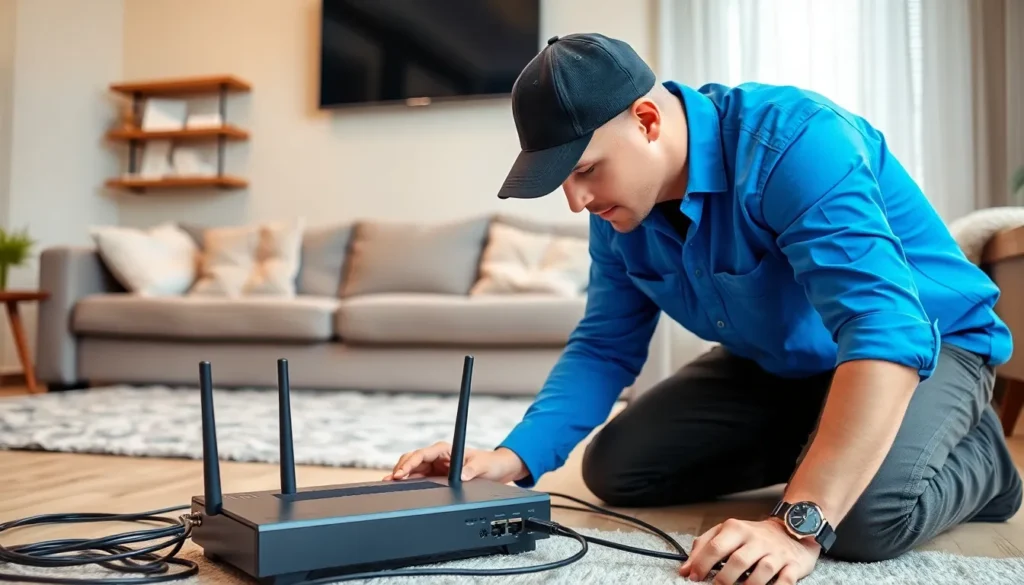Table of Contents
ToggleIn today’s world, a reliable home network is as essential as a good cup of coffee—without it, chaos reigns. Whether it’s streaming the latest binge-worthy series or video chatting with grandma, a stable connection keeps everything running smoothly. But let’s face it, setting up a home network can feel like trying to assemble IKEA furniture without the instructions.
That’s where home networking installation services come to the rescue. These pros swoop in like superheroes, transforming tangled cords and confusing settings into a seamless experience. With their expertise, they ensure your devices are connected and your Wi-Fi reaches every corner of your home—no more dead zones or buffering frustrations. So, why wrestle with cables and settings when you can sit back and let the experts handle it?
Overview of Home Networking Installation Services
Home networking installation services provide essential support for creating reliable and efficient networks. These services typically include site assessments, equipment recommendations, and installation setups tailored to individual homes. Professionals evaluate signal strengths, identify dead zones, and recommend optimal router placements for improved connectivity.
Installation services often involve setting up a variety of devices, including routers, switches, and access points. Experts ensure that all components are properly configured, integrating both wired and wireless solutions. During the process, technicians can also enable network security features, helping safeguard personal data from potential threats.
Optimizing bandwidth is another critical aspect of these services. Technicians utilize tools to analyze network performance and make adjustments to improve speed and stability. By configuring Quality of Service settings, they prioritize essential tasks such as video streaming and online gaming, ensuring a seamless experience throughout the home.
Home networking installation services also support smart home devices. As homes become increasingly automated, these professionals integrate various devices into the network efficiently. Ensuring compatibility and minimizing connection issues simplifies control over smart appliances, enhancing overall functionality.
Many service providers also offer ongoing support and maintenance options. Routine checkups can help identify potential issues before they escalate, guaranteeing continuous network performance. By investing in these services, homeowners gain peace of mind, knowing their networks are up-to-date and functional.
Benefits of Professional Installation

Professional installation of home networking services offers valuable advantages for homeowners seeking reliable connectivity. This expertise leads to optimized network performance and enhanced security measures.
Improved Network Performance
Enhanced network performance results from specialized skills in setting up and configuring devices. Technicians assess site conditions, identify weak signal areas, and recommend optimal router locations. Properly configured systems minimize dead zones, ensuring devices maintain strong connections. Effective bandwidth management prioritizes critical tasks, enhancing experiences during activities like streaming and gaming. Continuous monitoring by professionals allows quick adjustments in response to changing network demands. These improvements lead to seamless, reliable access across all connected devices.
Enhanced Security Measures
Professional installation significantly enhances network security. Technicians implement advanced encryption protocols and solid passwords, protecting sensitive data from unauthorized access. Regular security assessments help identify vulnerabilities in the home network. Firewalls can be configured to guard against external threats. Setup of guest networks prevents intruders from accessing primary network resources. Technicians also provide training on security best practices to homeowners, ensuring computer hygiene is maintained. This proactive approach fosters a safer online environment for all users.
Types of Home Networking Solutions
Home networking solutions fall into two main categories: wired and wireless. Each option serves distinct needs based on a home’s layout and usage.
Wired Networking Options
Wired networking options utilize Ethernet cables for connections. These connections provide stable and reliable internet access throughout the home. Many homeowners prefer wired setups for activities demanding high bandwidth, such as online gaming or streaming 4K videos. Technicians typically install wall jacks to create access points in preferred locations. They prioritize placement to reduce cable clutter and optimize network performance. Businesses and gamers often favor wired options for minimal latency and consistent speeds. Data transmissions remain secure and fast, ensuring a seamless online experience.
Wireless Networking Solutions
Wireless networking solutions offer flexibility by eliminating the need for cables. Wi-Fi networks allow devices to connect from various locations within the home. Homeowners appreciate the convenience of mobile devices connecting easily in any room. Wireless access points and routers should be strategically placed to enhance coverage and minimize dead zones. Professionals can recommend advanced mesh systems to improve connectivity across larger spaces. These systems work together to provide a consistent signal, especially in multi-story homes. Security features, including encryption, ensure a safe browsing experience, making wireless solutions an appealing choice for modern households.
Choosing the Right Service Provider
Choosing the right service provider for home networking installations ensures optimal performance and security. This decision impacts not only connectivity but also the overall functionality of smart devices.
Qualifications to Look For
Assessing qualifications is vital. Look for certified professionals with experience in networking technologies. Ensure they possess expertise in both wired and wireless solutions. Knowledge of current security protocols is essential, as this impacts data protection. Additionally, consider providers who offer ongoing support and maintenance for lasting assistance.
Questions to Ask
Asking the right questions is crucial. Inquire about the provider’s experience with similar installations. Explore their approach to troubleshooting common issues, such as dead zones. Confirm what types of equipment they recommend and the reasoning behind those choices. Lastly, clarify support options available after installation, ensuring responsiveness to any future network concerns.
Common Challenges in Home Networking
Home networks present several common challenges that can affect performance and reliability. Understanding these difficulties aids in effective solutions.
Troubleshooting Connectivity Issues
Connectivity issues often emerge unexpectedly, creating frustration. Slow internet speeds can disrupt streaming or gaming experiences. Checking physical connections, such as Ethernet cables and router status, serves as an initial troubleshooting step. Conducting speed tests helps identify problems, ensuring users can pinpoint areas of concern. Restarting the modem and router frequently resolves temporary failures and restores connection stability. Additionally, professionals recommend firmware updates for devices, enhancing overall network performance and security.
Dealing with Interference
Interference from various sources can compromise network efficacy. Walls, large appliances, and even neighboring Wi-Fi networks typically interfere with signals. Using dual-band or tri-band routers can minimize these disruptions, as they offer multiple channels for device connections. Strategically placing routers in open areas helps improve signal strength. Proofing against interference might also involve identifying and eliminating potential obstructions, enhancing overall coverage. Understanding the environment allows homeowners to better manage their networks, ensuring devices remain connected without constant disconnection or slowdown.
Investing in home networking installation services can transform a frustrating setup into a seamless experience. With expert assistance, homeowners can enjoy enhanced connectivity and security throughout their spaces. Professionals not only optimize network performance but also ensure that smart devices integrate smoothly.
By choosing the right service provider, individuals can access tailored solutions that fit their specific needs. This proactive approach minimizes potential issues and fosters a reliable online environment. Ultimately, a well-installed home network enhances daily digital activities, providing peace of mind and a better quality of life.







